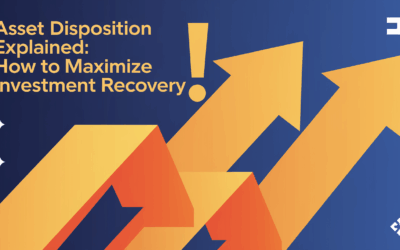Streamlining Efficiency: Best Practices in Corporate Surplus Asset Disposition
The corporate landscape has grown to become more competitive with increased pressures on operations and margins. The latest in the series are the global supply chain disruptions and shortages of critical components in manufacturing. Businesses today, more so than ever, require better management of assets and resources. At such a juncture, it is easy to focus on efficient procurement, however, what tends to get overlooked is the effective and strategic corporate surplus asset disposition and management.
So, let’s delve deeper into what corporates can adopt as best practices to improve resource management and streamline efficiency.
Understanding Corporate Surplus Asset Disposition
Organizations tend to accumulate surplus assets over a period of time. This happens due to a variety of reasons including, the evolution of technology, changes in business strategy or consumer behavior, environmental norms, or other regulatory changes. How an organization deals with these assets can unlock huge benefits in operational efficiency, sustainability, and revenue generation.
Asset Disposition, in simple terms, is the process of retiring or disposing of the surplus or outdated assets that have reached the end of their functional life and are of no longer of use to the business for financial and operational benefits. The process essentially involves
- Identifying the surplus assets that are no longer required by the company
- Evaluating and assessing their estimated resale value for maximum gain
- Figuring out the right reselling method and channel depending on the type of asset
- Reselling the surplus assets for the best possible financial gains and environmental gains
Best Practices for Corporate Surplus Asset Disposition
Let us understand some effective strategies with respect to the key steps that make the whole process operationally efficient and effective.
Identifying Surplus Assets
The first and most crucial step is to identify which assets have become obsolete and redundant over time for disposing of. This can be achieved by assessing the condition, age, and functionality of the asset.
Best practices you can consider implementing
The organization can deploy a Centralised Asset Management System or a dedicated team of employees to maintain and track the life and functionality of company assets. A dedicated system or team ensures regular audits for identifying surplus assets, enabling a more streamlined asset management and identification process. This practice will eventually become an active part of the organizational process rather than just a one-time event.
Assessing the Value of the Asset
This step is to assess the estimated residual and resale value of the surplus asset at the end of its life. This helps the sellers to anticipate and estimate the accurate value and price at which the asset can be sold.
Best practices you can consider implementing
In order to estimate or assess the value of an asset,
- Take into consideration the age, condition, estimated lifespan, repair and maintenance costs, as well as the depreciation cost of the asset
- Secondly, conduct a market analysis to get a better understanding of the current price and demand of the asset
- Lastly, consider taking services for a third-party assessment for a better understanding and evaluation and to gain valuable insights and proper guidance
Finding the Right Buyer
To make sure you receive the highest value for your assets requires finding buyers who are prepared to offer the appropriate price. But what strategies can you employ to identify these ideal buyers?
Best practices you can consider implementing
- Conduct thorough market analysis to identify potential buyers within and outside your industry who value your surplus assets highly.
- Leverage online marketplaces and auction sites tailored to your asset type to reach a broader, targeted audience interested in your assets.
- Tap into your industry networks, including trade associations and professional groups, to spread the word and find interested buyers through referrals.
- Collaborate with experienced brokers who specialize in your asset type to access their network of pre-qualified buyers and expertise in closing deals efficiently.
Implementing the Asset Disposition Plan
An asset disposition plan outlines the process for disposing of surplus assets, ensuring compliance with legal and environmental regulations, and aiming to maximize the return or minimize the costs associated with the disposal. This plan is crucial for efficient asset management and optimized operations.
Best practices you can consider implementing
Generally, an asset can be disposed of through multiple channels depending on the product category and evaluation. Here are the ways and means that can be evaluated for optimum revenue generation.
- Auction: This involves selling the product through a bidding process. These auctions are generally held on-site or online and generate a lot of interest and competition among buyers.
- Private sale: As the name suggests, it involves selling the assets directly to a buyer.
- Third-party selling: This process involves a third-party expert who sells the product on behalf of the company for a predefined commission.
Asset Recycling and Repurposing
Another environmentally responsible disposition of surplus assets apart from revenue generation through reselling, is recycling and repurposing the asset.
Best practices you can consider implementing
- The assets can be reused and refurbished for internal use instead of reselling. At times, when the assets might be redundant for one department can be useful for the other. So instead of selling, they can be refurbished and repurposed internally.
- Companies can also partner with vendors to provide exchange services for old assets. So instead of reselling, the obsolete asset can be returned and replaced with the latest upgrade of the same.
- Donating surplus assets is also considered a good industry practice as it ends up benefitting the receiver, maintains a healthy industry reputation, and helps clear up the space by reducing surplus inventory.
Tracking the Disposition Process
During the process, critical data and information such as sale prices, time to sell, demand and disposal costs should be tracked for a better understanding of the procedure and future references.
Best practices you can consider implementing
Continuously reviewing and refining the asset disposition process based on feedback, market trends, and emerging best practices helps in adopting a flexible approach moving forward that is both financially and environmentally viable.
Final Words
In summary, effective corporate surplus asset disposition is vital for enhancing operational efficiency, financial returns, and sustainability in today’s competitive environment. By adopting key best practices such as centralized asset management, accurate value assessment, diversified disposal strategies, and asset recycling, companies can significantly benefit from their surplus assets.



